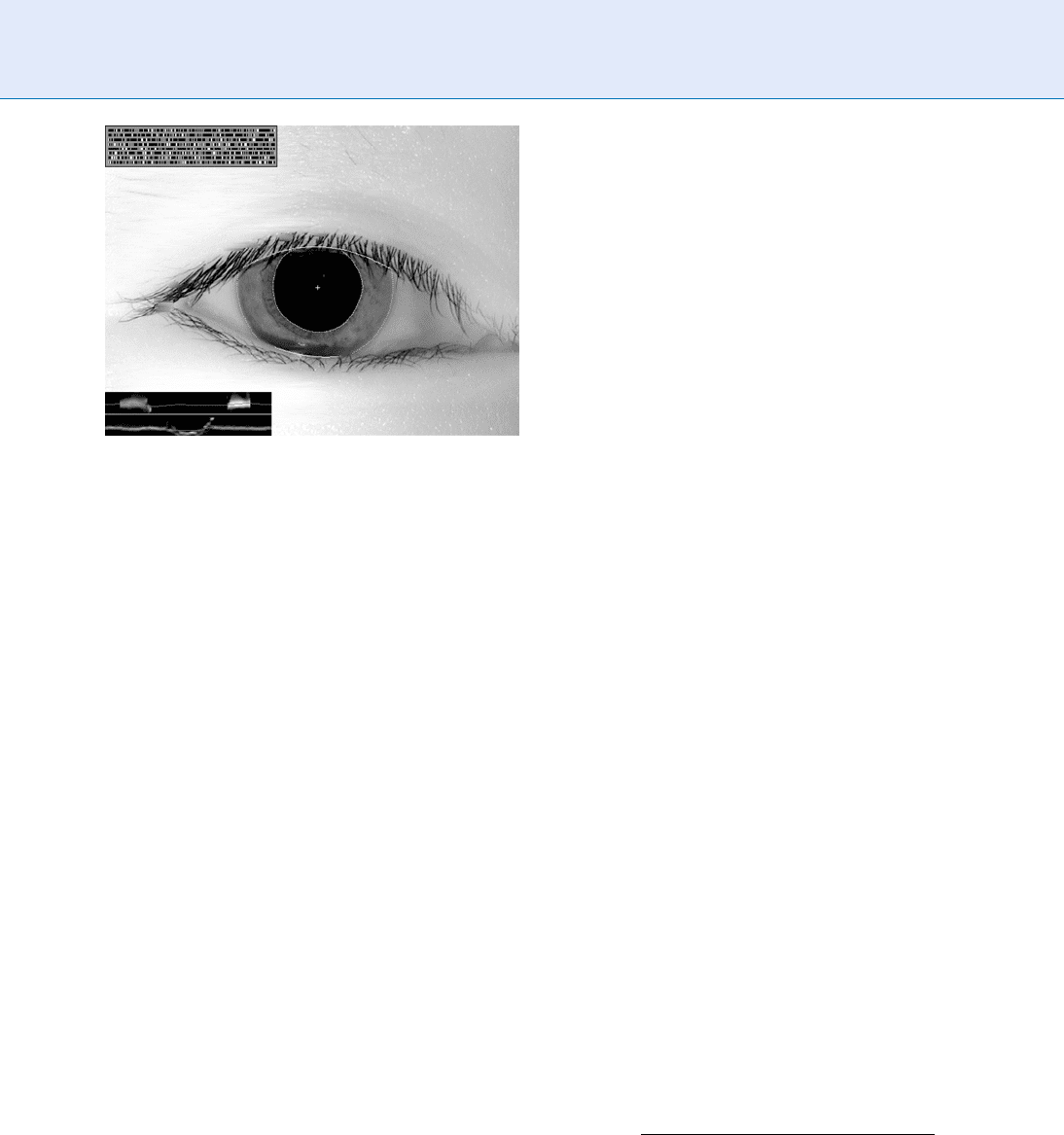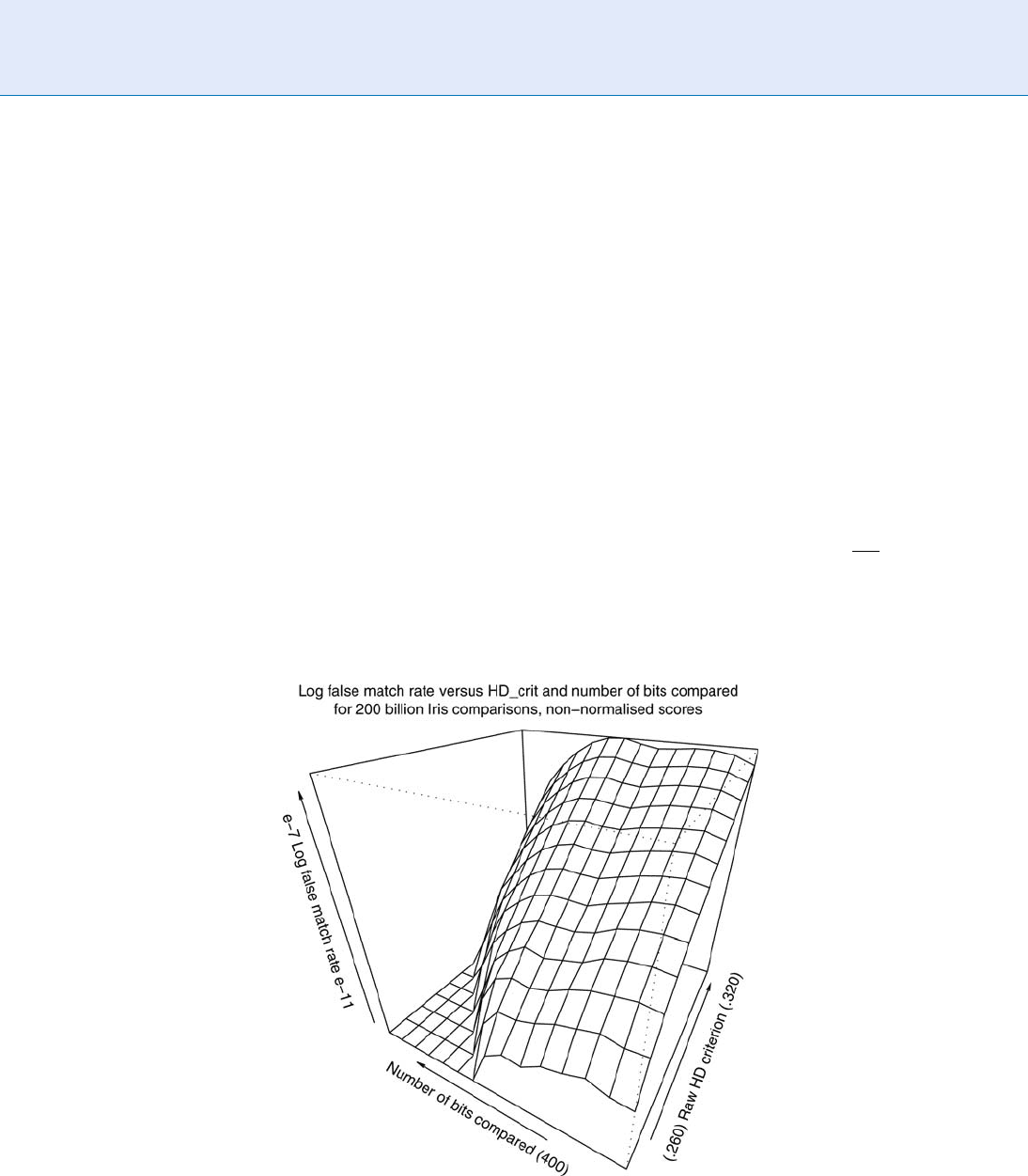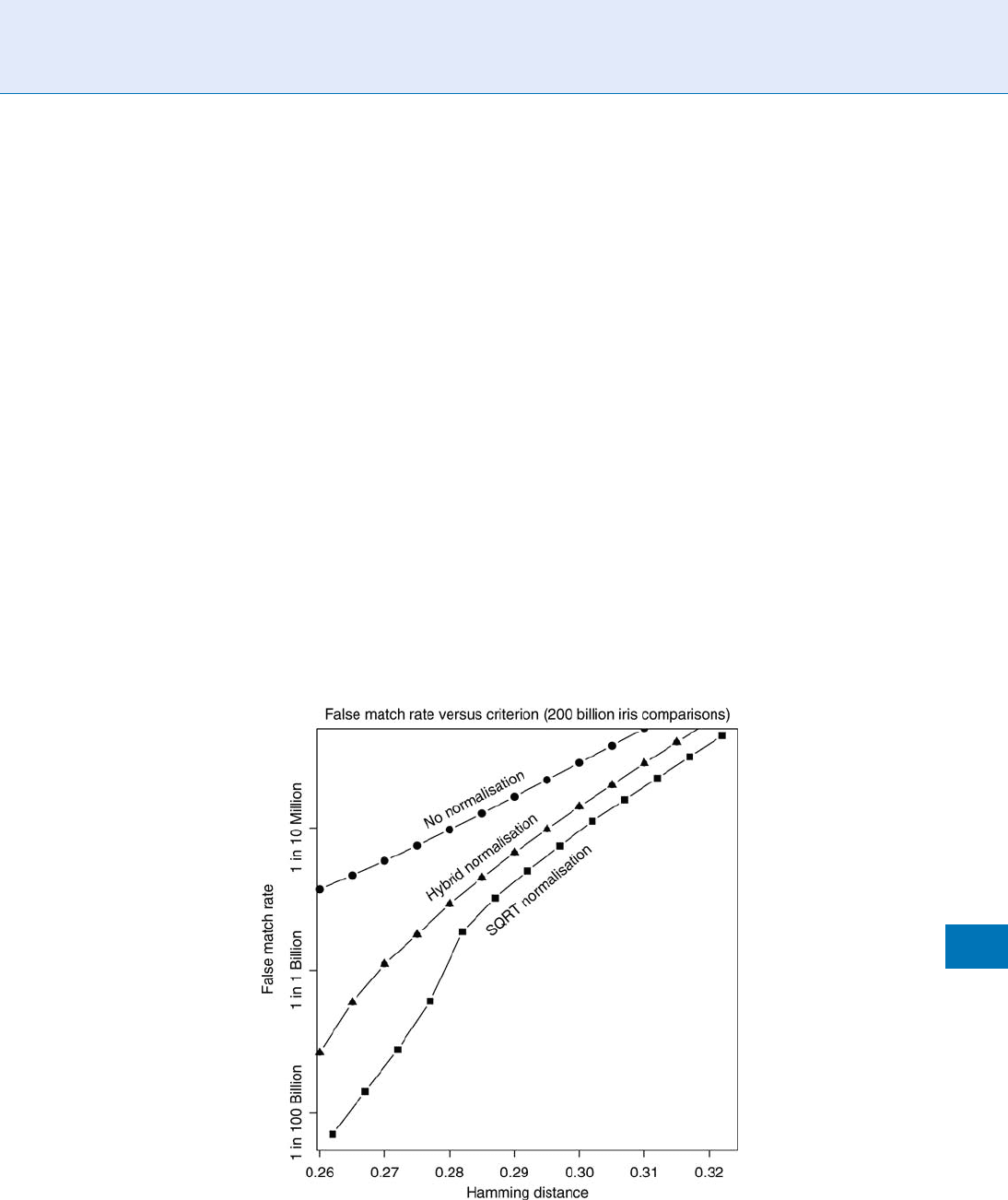Li S.Z., Jain A.K. (eds.) Encyclopedia of Biometrics
Подождите немного. Документ загружается.


▶ Palm Vein recognition
▶ Vein and Vascular recognition
References
1. Time.com: www.time.com/time/printout/0,8816,755453,00.html
2. Jain, A., Ruud, B., Sharath, P. et al.: Biometrics personal Identi-
fication in Network Society, pp. 123–141. Kluwer Academic
Publishers, Dorrecht (1999)
3. Ruud, M.B., Jonathan, H.C., Sharath, P., Nalini, K.R., Andrew,
W.S.: Guide to Biometrics, pp. 53–54. Springer, Heidelberg
(2004)
4. Nanili, K.R., Venu, G.: Advances in Biometrics Sensor, Algo-
rithms and Systems, pp. 133–155. Springer, Heidelberg (2008)
Retinal Angiogenesis
The formation of retina blood vessels by budding or
sprouting from existing vessels. Random processes
during retinal angiogenesis are thought to be responsi-
ble for the unique nature of the retinal blood vessel
network.
▶ Simultaneous Capture of Iris and Retina fo r
Recognition
Retinal Blood Vessels
The retina receives blood from two sources, the cho-
roidal capillaries and the central retinal artery. The
retinal and choroidal blood vessel pattern is unique
to every person. The branches of the central artery and
vein, for instance, diverge from the optic disc in a
distinctive pattern that varies considerably across indi-
viduals. These retinal blood vessels are readily visible
on a regular fundus photograph taken with visible
light, whereas the choroidal blood vessels, forming a
matting behind the retina, become visible when ob-
served with near-infrared illumination.
▶ Anatomy of Eyes
Retinal Scan
▶ Retina Recognition
Reverse Engineering
Reverse Engineering refers mechanical disassembling
and software analysis for architectural parsing for
product to study/investigate operational mechanisms
and its source code, etc.
▶ Embedded Systems
Revocable Biometrics
▶ Cancelable Biometrics
Ridge Enhancement
▶ Fingerprint Image Enhancement
Ridge Extraction
▶ Fingerprint Image Enhancement
Ridge Flow
The direction and overall pattern of a group of ridges
in an area of friction ridge skin.
▶ Anatomy of Friction Ridge Skin
1130
R
Retinal Angiogenesis

Robustness Test
Test to evaluate how much a certain influencing factor
can affect biometric performance is robustness test.
▶ Influential Factors to Performance
ROC Curve
An ROC (receiver operating characteristic) curve is a
plot commonly used in machine learning and data
mining for exhibiting the performance of a classifier
under different criteria. The y-axis is the true positive
and the x-axis is the false positive (i.e., false alarm).
A point on ROC curve shows that the trade-off be-
tween the achieved true positive detection rate and
the accepted false positive rate.
▶ Face Detection
▶ Performance Measures
Rolled-Equivalent Fingerprint
It refers to a special impression of the fingerprint
obtained by rolling the finger around the main finger
axis on a planar surface.
▶ Fingerprint, Palmprint, Handprint and Soleprint
Sensor
Rolls Capture Device
It refers to a fingerprint device that allows the capture
of rolled equivalent fingerprints. A special reconstruc-
tion algorithm is needed to compose the fingerprint
during the rolling of the finger on the surface.
▶ Fingerprint, Palmprint, Handprint and Soleprint
Sensor
Rotation Angle
The rotation angle is the angle between the line joining
the left and right pupil centers and the hor izontal axis
of the iris camera system. Counterclockwise rotation of
the head about the optical axis of the camera is consid-
ered positive and clockwise rotation is considered
negative.
▶ Iris Image Data Interchange Formats, Standardization
▶ Pose
Rotation Angle
R
1131
R


S
Sample Quality
The intrinsic characteristic of a biometric signal may
be used to determine its suitability for further proces-
sing by the biometric system or to assess its confor-
mance to preestablished standards. The quality of a
biometric signal is a numerical value (or a vector)
that measures this intrinsic attribute (See also
▶ Bio-
metric Sample Qu ality).
▶ Biometric Algorithms
▶ Fusion, Qualit y-Based
Sample Size
▶ Manifold Learning
▶ Performance Evaluation, Overview
▶ Test Sample and Size
Sampling Frequency
Sampling frequency is the number of sam ples captured
in a second from the continuous hand-drawn signal to
generate a discrete signal.
▶ Digitizing Table t
Scalability
Scalability is the ability of a biometric system to extend
adaptively to larger population without requiring
major changes in its infrastructure.
▶ Performance Evaluation, Overview
Scenario Tests
Scenario tests are those in which biometric systems
collect and process data from test subjects in a speci-
fied application. An essential characteristic of scenario
testing is that the test subject is ‘‘in the loop,’’ inter-
acting with capture devices in a fashion representative
of a target application. Scenario tests evaluate end-
to-end systems, inclusive of capture device, quality
validation software, enrollment software, and match-
ing software.
▶ Performance Testing Methodology Standardization
Scene Marks
Crime scene marks are generally any physical phenom-
enon created or left behind and in relation to a crime
scene, these can be fingerprints, blood spatter,
#
2009 Springer Science+Business Media, LLC

intentional and unintentional damage, or alteration to
objects in the environment of the crime.
▶ Footwear Recognition
Scent Identification Line-Ups
Procedure where a trained dog matches a sample odor
provided by a person to its counterpart in an array (or
line-up) of odors from different people , following a
fixed protocol. Scent identification line-ups are used in
forensic investigations as a tool to match scent traces
left by a perpetrator at a crime scene to the odor of a
person suspected of that crime. The protocol includes
certification of the team involved, collecting and con-
serving scent samples at crime scenes, collecting, con-
serving and presenting suspect, and other array odors,
working procedures and reporting. Scent identification
line-ups have evolved from simple line-ups that are
used in human scent tracking/trailing, where a dog
has to walk up to the person whose track it has been
following and through some trained behavior indic ate
the person.
▶ Odor Biometrics
Score Fusion
▶ Fusion, Score-Level
▶ Multiple Experts
Score Fusion and Decision Fusion
Score fusion is a paradigm, which calculates similarity
scores for each of the two modalities, then combines
the two scores according to a fusion formula, e.g., the
overall score is calculated as the mean of the two
modality scores. Decision fusion is a paradigm, which
makes an accept–reject decision for each of the two
modalities, then combines the two decis ions according
to a fusion rule, e.g., the unknown sample is accepted
only if both modalities yield an accept decision.
▶ Multibiometrics, Overview
Score Normalization
The score normalization techniques aim, generally, to
reduce the scores variabilities in order to facilitate the
estimation of a unique speaker-independe nt threshold
during the decision step. Most of the current normaliza-
tion techniques are based on the estimation of the impos-
tors scores distribution where the mean, μ, and the
standard deviation v, depend on the considered speaker
model and/or test utterance. These mean and standard
deviation values will then be used to normalize any
incoming score s using the normalization function
scoreNðsÞ
s m
v
:
Two main score normalization techniques used in
speaker recognition are:
1. Znorm. The zero normalization (Znorm) method
(and its variants like Hnorm (Heck, L.P., Weintraub,
M.: Handset-dependent background models for ro-
bust text-independent speaker recognition. In:
ICASSP. (1997))) normalizes the score distribution
using the claimed speaker statistics. In other words,
the claimed speaker model is tested against a set of
impostors, resulting in an impostor similarity score
distribution which is then used to estimate the nor-
malization parameters μ and v. The main advantage
of the Znorm is that the estimation of these para-
meters can be performed during the tr aining step.
2. Tnorm. The test normalization (Tnorm)
(Auckenthaler, R., Carey, M., Lloyd-Thomas, H.:
Score normalization for text-independent speaker
verification system s. Digital Signal Processing
10 (2000) 4254) is another score normalization
technique in which the parameters μ and v are
estimated using the test utterance. Thus, during
testing, a set of impostor models is used to calculate
impostor scores for the given test utterance. μ and v
are estimated using these scores. The Tnorm is
known to improve the performances particularly
in the region of low false alarm.
1134
S
Scent Identification Line-Ups

Any of a number of rules for adjusting a raw simi-
larity score in a way that takes into account factors
such as the amount of data on which its calculation was
based, or the quality of the data. One purpose of score
normalization in biometrics is to prevent the arising of
false matches simply because only a few elements (e.g.,
biometric features) were available for comparison. So
an accidental match by chance would be more like
tossing a coin only a few times to produce a perfect
run of all head. Another purpose of score normalization
is to make it possible to compare or to fuse different
types of measurements, as in multibiometrics. For ex-
ample, Z-score normalization redefines every observa-
tion in units of standard deviation from the mean,
thereby allowing incommensurable scores (like height
and weight) to become commensurable (e.g., he is 3.2
standard deviations heavier than normal but 2.3 stan-
dard deviations taller than normal). Frequently the goal
of score normalization is to map samples from different
distributions into normalized samples from a universal
distribution. For example, in iris recognition a decision is
made only after the similarity score (fractional Hamming
Distance) has been converted into a normalized score
that compensates for the number of bits that were avail-
able for comparison, thereby preventing accidental False
Matches just because of a paucity of visible iris tissue.
▶ Score Normalization Rules in Iris Recognition
▶ Session Effects on Speaker Modeling
▶ Speaker Matching
Score Normalization Rules in Iris
Recognition
JOHN DAUGMAN
Cambridge University, Cambridge, UK
Synonyms
Commensurability; Decision criterion adjustment;
Error probability non-accumulation; Normalised
Hamming Distance
Definition
All biometric recognition systems are based on similarity
metrics that enable decisions of ‘‘same’’ or ‘‘different’’ to
be made. Such metrics require normalizations in order
to make them commensurable across comparison cases
that may differ greatly in the quantity of data available, or
in the quality of the data. Is a ‘‘perfect match’’ based only
on a small amount of data better or worse than a less
perfect match based on more data? Another need for
score normalization arises when interpreting the best
match found after an exhaustive search, in terms of the
size of the database searched. The likelihood of a good
match arising just by chance between unrelated templates
must increase with the size of the search database, simply
because there are more opportunities. How should a
given ‘‘best match ’’ score be interpr eted? Addressing
these questions on a principled basis requires models
of the underlying probability distributions that describe
the likelihood of a given degree of similarity arising by
chance from unrelated sources. Likewise, if comparisons
are required over an increasing range of image orienta-
tions because of uncertainty about image tilt, the proba-
bility of a good similarity score arising just by chance
from unrelated templates again grows automatically, be-
cause there are more opportunities. In all these respects,
biometric similarity
▶ score normalization is needed,
and it plays a critical role in the avoidance of False
Matches in the publicly deployed algorithms for iris
recognition.
Introduction
Biometric recognition of a person’s identity requires
converting the observed degree of similarity between
presenting and previously enrolled features into a deci-
sion of ‘‘same’’ or ‘‘different.’’ The previously enrolled
features may not be merely a single feature set obtained
from a single asserted identity, but may be a vast number
of such feature sets belonging to an entire national
population, when identification is performed by exhaus-
tively searching a database for a sufficiently good match.
The
▶ similarity metrics used for each comparison
between samples might be simple correlation statistics,
or vector projections, or listings of the features (like
fingerprint minutiae coordinates and directions) that
agreed and of those that disagreed as percentages of the
total set of features extracted. For each pair of feature
sets being compared, vary ing amounts of data may be
available, and the sets mig ht need to be compared
under various transformations such as image rotations
when the orientation is uncertain. An example is seen
Score Normalization Rules in Iris Recognition
S
1135
S

in Figure 1, in which only 56% of the annular iris area
is visible between the eyelids. Iris images may have also
been acquired with a tilted camera (not unusual for
handheld cam eras), or with the head tilted or the eye
rotated (cyclovergence) by an unknown degree, requir-
ing comparisons to be made over a range of configura-
tions for each of the possible identities, and with
varying amounts of template data being available in
each case. This article is concerned with the methods of
▶ score normalization that are used in iris recognition
to make all of those comparison cases
▶ commensura-
ble with each other, preventing False Match probability
from rising simply because there is less data available
for comparison or because there are many more can-
didates and match configurations to be considered.
Score Normalisation by the Amount
of Iris Visible
The algorithms used in all current public deployments
of iris recognition [2] work by a test of statistical
independence: A match is declared when two templates
fail the test of statistical independence; comparisons
between different eyes are statistically guaranteed to
pass that test [1]. The test of independence is based
on measuring the fraction of bits that disagreed be-
tween two templates, called
▶ IrisCodes, and so the
similarity metric is a
▶ Hamming Distance between
0 and 1. (The method by which an IrisCode is created
is described in this encyclopedia in the entry on Iris
Encoding and Recognition using Gabor Wavelets.)
If two IrisCodes were derived from different eyes,
about half of their bits should agree and half should
disagree (since any given bit is equally likely to be 1 or
0), and so a Hamming Distance close to 0.5 is expected.
If both IrisCodes were computed from the same
eye, then a much larger proportion of the bits should
agree since they are not independent, and so a
Hamming Distance much closer to 0 is expected. But
what is the effect of having varying numbers of
bits available for comparison, for example, because
of eyelid occlusion?
Eyelid boundaries are detected (as illus trated by the
spline curve graphics in Figure 1 where each lid inter-
sects the iris), and the parts of the IrisCode that are
then unavailable are marked as such by setting masking
bits. The box in the lower-left corner of Figure 1 shows
Active Contours computed to describe the pupil
boundary (lower ‘‘snake’’) and the iris outer boundary
(upper snake). As these snakes are curvature maps, a
circular boundary would be described by a snake that
was flat and straight. The two thick grey regions in the
box containing the upper snake represent the limited
regions where the iris outer boundary is visible and
possesses a large radial gradient (or derivative) in
brightness. The gaps that separate the two thick grey
regions correspond to parts of the trajectory around
the iris where no such boundary is visible, because it is
occluded by eyelids. Thus the outer boundary of the
iris must be estimated (dotted curve) by two quite
limited areas on the left and right sides of the iris
where it is visible. In the coordinate system that results,
the iris regions obscured by eyelids are marked as such
by masking bits.
The logic for comparing two IrisCodes to generate a
raw Hamming Distance HD
raw
is given in Equ ation (1 ),
where the data parts of the two IrisCodes are denoted
{codeA, codeB} and the vectors of corresponding mask-
ing bits are denoted {maskA, maskB}:
HD
raw
¼
kðcodeA codeBÞ
T
maskA
T
maskBk
kmaskA
T
maskBk
ð1Þ
The symbol
N
signifies the logical Exclusive-OR
(XOR) operator which detects disagreement between
bits;
T
signifies logical AND whereby the masks dis-
count data bits where occlusions occurred; and the
norms kkcount the number of bits that are set in
the result. Bits may be mas ked for several reasons other
than eyelid or eyelash occlusion. They are also deeme d
Score Normalization Rules in Iris Recognition. Figure 1
Illustration of limited data being available in an iris image due
to eyelid occlusion, as detected in a segmentation process.
1136
S
Score Normalization Rules in Iris Recognition

unreliable if specular reflections are detected in the
part of the iris they encode, or if the signal-to-noise
ratio there is poor, for example, if the local texture
energy is so low that the computed wavelet coefficients
fall into the lowest quartile of their distribution, or on
the basis of low entropy (informat ion density).
The num ber of bits pairings available for compari-
son between two IrisCodes, kmaskA
T
maskBk,is
usually almost a thousand. But if one of the irises
has (say) almost complete occlusion of its upper half
by a drooping upper eyelid, and if the other iris being
compared with it has almost complete occlusion of its
lower half, then the common area available for com-
parison may be almost nil. How can the test of statisti-
cal independence remain a valid and powerful basis for
recognition when very few bits are actually being com-
pared? It may well be that a less exact match on a larger
quantity of data is better evidence of a match than is a
perfect match on less data. An excellent analogy is a
test of whether or not a coin is ‘‘fair’’ (i.e., gives unbi-
ased outcomes when tossed): Getting a result of 100%
‘‘heads’’ in few tosses (e.g., 10 tosses) is actually much
more consistent with it being a fair coin than getting a
result of 60% / 40% after 1,000 tosses. (The latter result
is 6.3 standard deviations away from expectation,
whereas the former result is only 3.2 standard devia-
tions away from expectation; so the 60/40 result is
actually much stronger evidence against the hypothe-
sis of a fair coin, than is the result of ‘‘all heads in
10 tosses’’.) Similarly, in biometric comparisons, getting
perfect agreement between two samples that extracted
only ten features may be much weaker evidence of a
good match than a finding of 60% agreement among
a much larger number of extracted features.
This is illustrated in Table 1 for an actual database
of 632,500 IrisCodes computed from different eyes in
a border-crossing application in the Middle East [3].
A database of this size allows 200 billion di fferent
pair comparisons to be made, yielding a distribution
of 200 billion HD
raw
similarity scores between different
eyes. These HD
raw
scores were broken down into seven
categories by the number of bits mutually available for
comparison ( i.e., unmasked) between each pair of Iris-
Codes; those bins constitute the columns of Table 1,
ranging from 400 bits to 1,000 bits being compared.
The rows in Table 1 each correspond to a particular
decision threshold being applied; for example, the first
row is the case that a matc h is declared if HD
raw
is
0.260 or smaller. The cells in the Table give the ob-
served False Match Rate in this database for each
decision rule and for each range of numbers of bits
being compared when computing HD
raw
.
Using the findings in Table 1, it is informative to
compare performance for two decision criteria: a very
conservative criterion of HD
raw
¼0.260 (the first row),
and a more liberal criterion HD
raw
¼ 0.285 (the sixth
row) which allows more bits to disagree (28.5%) while
still declaring a match. Now if the False Match Rates
Score Normalization Rules in Iris Recognition. Table 1 False match rate without score normalisation: dependence on
number of bits compared and criterion
HD
Crit
400 bits 500 bits 600 bits 700 bits 800 bits 900 bits 1,000 bits
0.260 2 10
9
5 10
10
3 10
10
1 10
10
000
0.265 3 10
9
8 10
10
5 10
10
2 10
10
4 10
11
00
0.270 4 10
9
1 10
9
9 10
10
5 10
10
2 10
10
00
0.275 7 10
9
2 10
9
1 10
9
9 10
10
5 10
10
3 10
11
0
0.280 1 10
8
4 10
9
2 10
9
2 10
9
1 10
9
2 10
10
0
0.285 2 10
8
7 10
9
4 10
9
3 10
9
2 10
9
5 10
10
2 10
11
0.290 3 10
8
1 10
8
8 10
9
7 10
9
4 10
9
1 10
9
1 10
10
0.295 4 10
8
2 10
8
1 10
8
1 10
8
9 10
9
3 10
9
4 10
10
0.300 6 10
8
3 10
8
3 10
8
2 10
8
2 10
8
7 10
9
9 10
10
0.305 9 10
8
6 10
8
5 10
8
4 10
8
4 10
8
1 10
8
2 10
9
0.310 1 10
7
1 10
7
8 10
8
8 10
8
7 10
8
3 10
8
5 10
9
0.315 2 10
7
2 10
7
1 10
7
2 10
7
1 10
7
6 10
8
1 10
8
0.320 3 10
7
3 10
7
2 10
7
3 10
7
3 10
7
1 10
7
2 10
8
Score Normalization Rules in Iris Recognition
S
1137
S

are compared in the first and last columns of these
rows, namely when only about 400 bits are available for
comparison and when about 1,000 bits are compared,
it can be seen that, in fact, the more conservative
criterion (0.260) actually produces 100 times more
False Matches using 400 bits than does the more liberal
(0.285) criterion when using 1,000 bits. Moreover, the
row corresponding to the HD
raw
¼ 0.285 decision
criterion reveals that the False Match Rate is 1,000
times greater when only 400 bits are available for
comparison than when 1,000 bits are compared.
The numerical data of Table 1 is plotted in Figure 2
as a surface, showing how the logarithm of the False
Match Rate decays as a function of both variables. The
surface plot reveals that there is a much more rapid
attenuation of False Match Rate with increase in the
number of bits available for comparison (lower-left
axis), than by reduction of the HD
raw
decision cri terion
in the range of 0.260 - 0.320 (lower-right axis). This
is to be expected, given that iris recognition works by
a test of statistical independence. The observations of
Table 1 and Figure 2 clearly demonstrate the need for
similarity scores to be normalized by the number of
bits compared when calculating them.
A natural choice for the scor e normalization rule is to
rescale all deviations from HD
raw
¼ 0.5 in proportion
to the square-root of the number of bits that were com-
pared when obtaining that score. The reason for such a
rule is that the expected standard deviation in the distri-
bution of coin-tossing outcomes (expressed as a fraction
of the n tosses having a given outcome), is s ¼
ffiffiffiffiffiffiffiffiffiffi
pq=n
p
where p and q a re the respective outcome probabilities
(both nominally 0.5 in this case). Thus, decision con-
fidence levels can be maintained irrespective of how
many bits n were actually compared, by mapping each
raw Hamming Distance HD
raw
into a normalized score
HD
norm
using a re-scaling rule such as:
HD
norm
¼ 0:5 ð0:5 HD
raw
Þ
ffiffiffiffiffiffiffi
n
911
r
ð2Þ
This normalization should transform all samples of
scores obtained when comparing different eyes into
Score Normalization Rules in Iris Recognition. Figure 2 The data of Table 1 plotted as a surface in semilogarithmic
coordinates, showing a range factor of 10,000-to-1 in the False Match Rate as the number of bits compared ranges
from 400 to 1,000. This bit count is more influential than is the HD
raw
decision criterion for unnormalised scores in the
0.260 - 0.320 range.
1138
S
Score Normalization Rules in Iris Recognition

samples drawn from the same ▶ binomial distribution,
whereas the raw scores HD
raw
might be samples from
many different binomial distributions having standard
deviations s dependent on the number of bits n that
were actually available for comparison. This normali-
zation maintains constant confidence levels for deci-
sions using a given Hamming Distance threshold,
regardless of the value of n. The scaling parameter
911 is the typical number of bits compared
(unmasked) between two different irises.
The effect of using this normalization rule
(‘‘SQRT’’) is shown in Figure 3 for the 200 billion
comparisons between different irises, plotting the ob-
served False Match Rate as a function of the new
HD
norm
normalized decision criterion. Also shown
for comparison is the unnormalized case (upper
curve), and a ‘‘hybrid’’ normalization rule which is
a linear combination of the other two, taking into
account the number of bits compared only when in
a certain range [4]. The benefit of score normalization
is profound: it is noteworthy that in this semilogarith-
mic plot, the ordinate spans a factor of 300,000 to 1.
The price paid for achieving this profound benefit
in robustness against False Matches is that the match
criterion becomes more demanding when less of the
iris is visible. Table 2 shows what fraction of bits HD
raw
(column 3) is allowed to disagree while still accepting
a match, as a function of the actual number of bits that
were available for comparison (column 1) or the ap-
proximate percent of the iris that is visible (column 2).
In every case shown in this Table, the probability of
making a False Match is about 1 in a million; but it is
clear that when only a very little part of two irises can
be compared with each other, the degree of match
required by the decision rule becomes much more
demanding. Conversely, if more than 911 bits (the
typical case, corresponding to about 79% of the iris
being visible) are available for comparison, then the
decision rule becomes more lenient in terms of the
acceptable HD
raw
while still maintaining the same net
confidence level.
Finally, anoth er cost of using this score norma liza-
tion rule is apparent if one operates in a region of the
ROC curve corresponding to a very nondemanding
Score Normalization Rules in Iris Recognition. Figure 3 Comparing the effects of three score normalisation rules on
False Match Rate as a function of Hamming Distance.
Score Normalization Rules in Iris Recognition
S
1139
S
